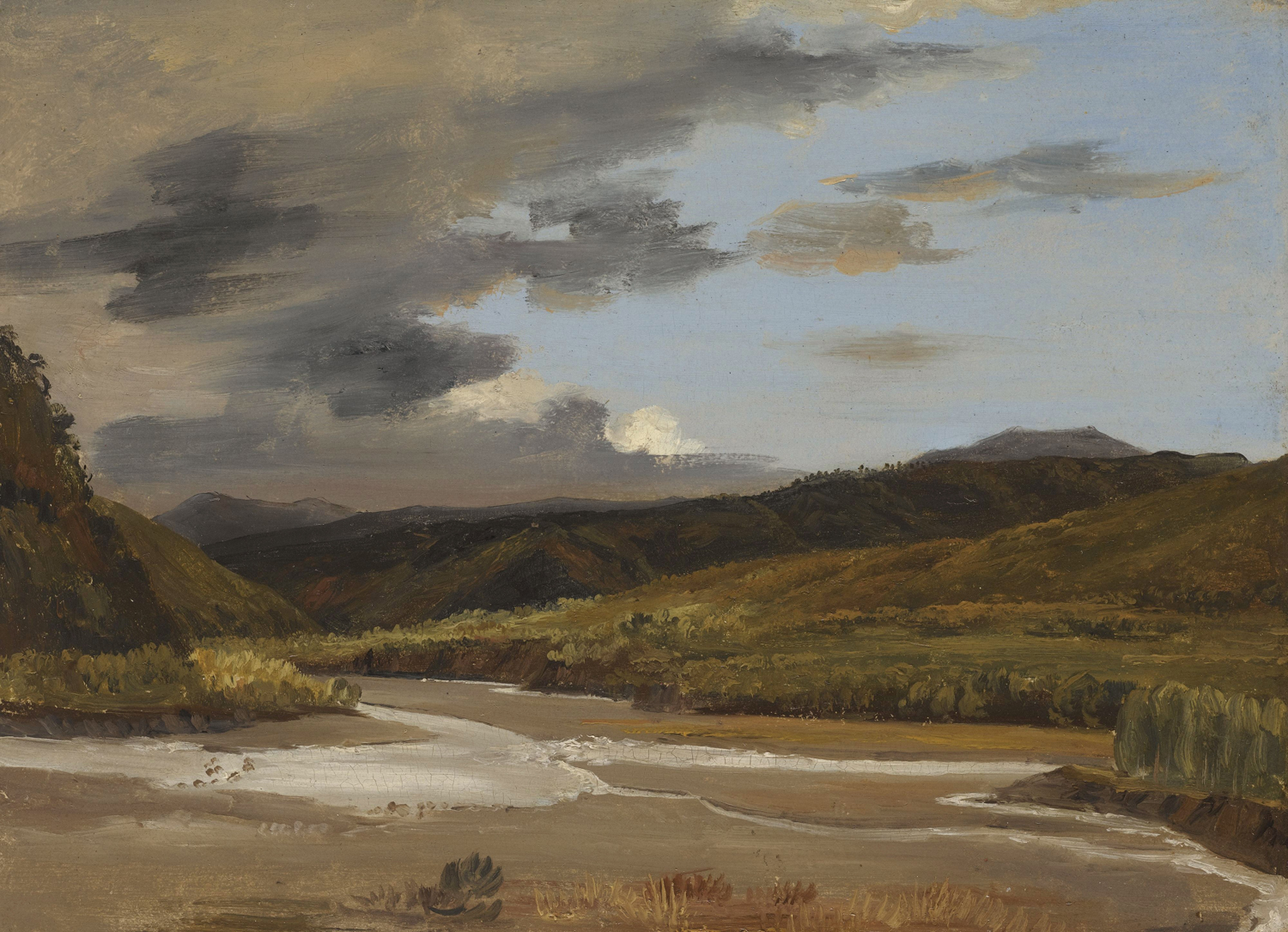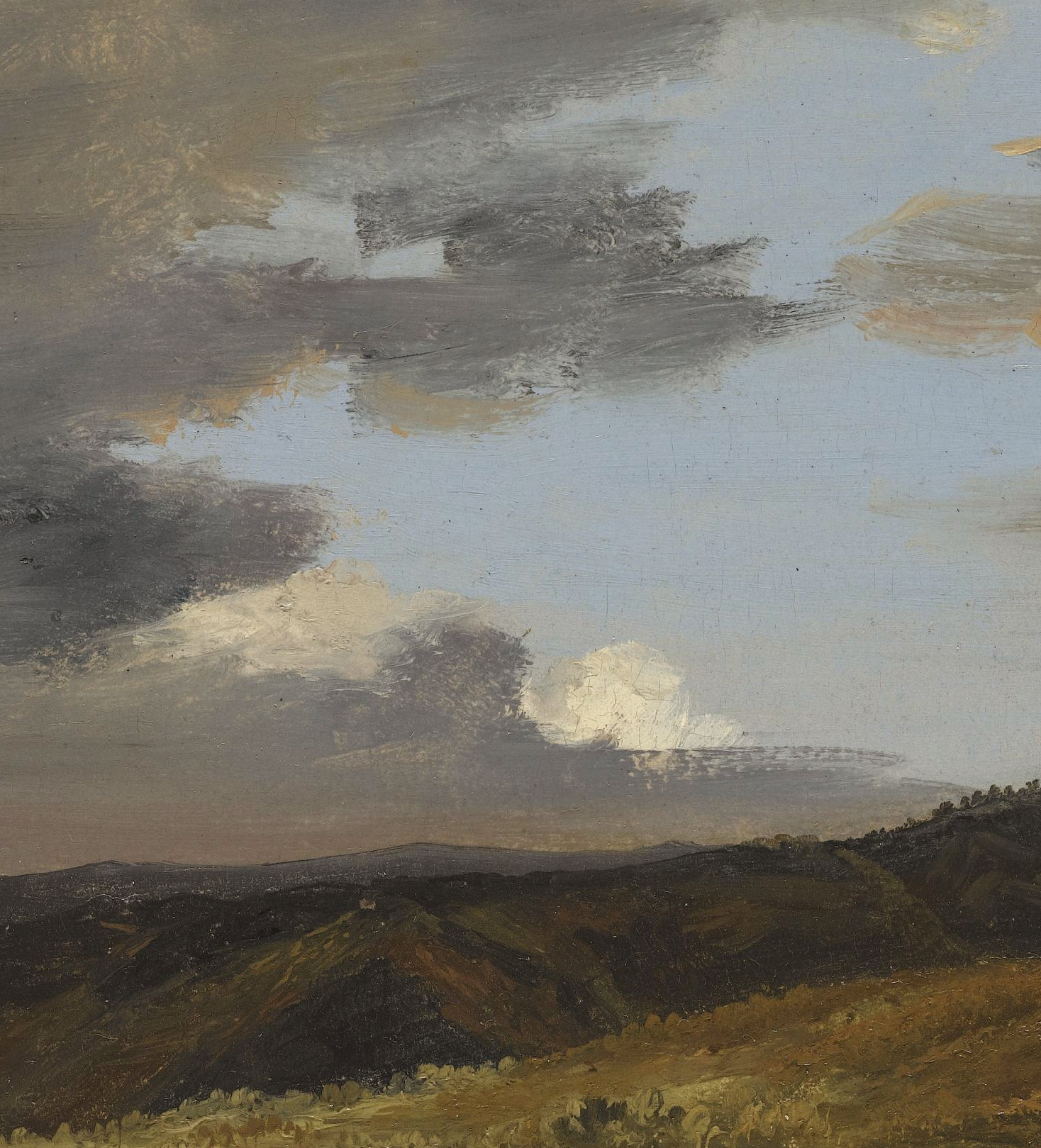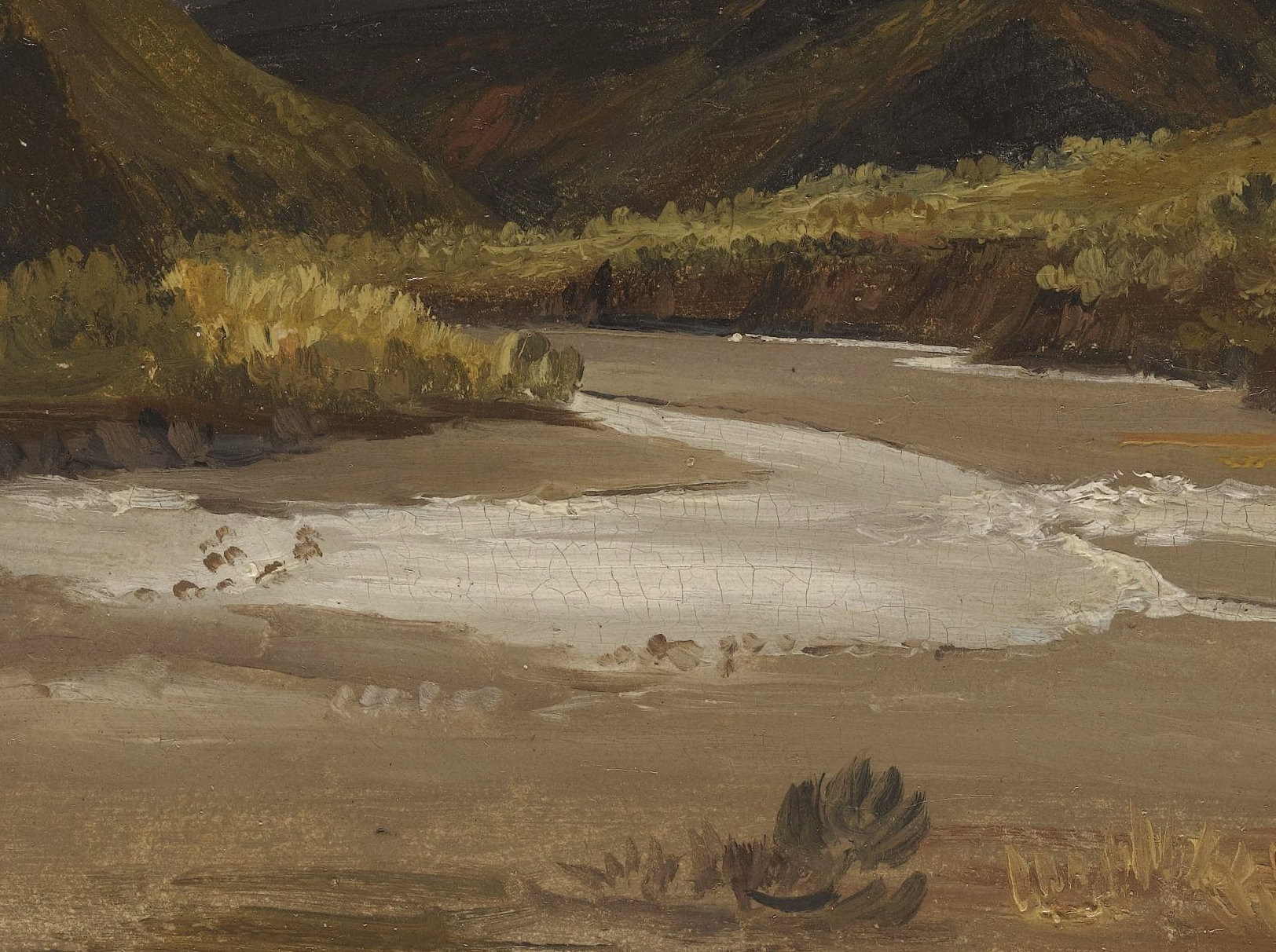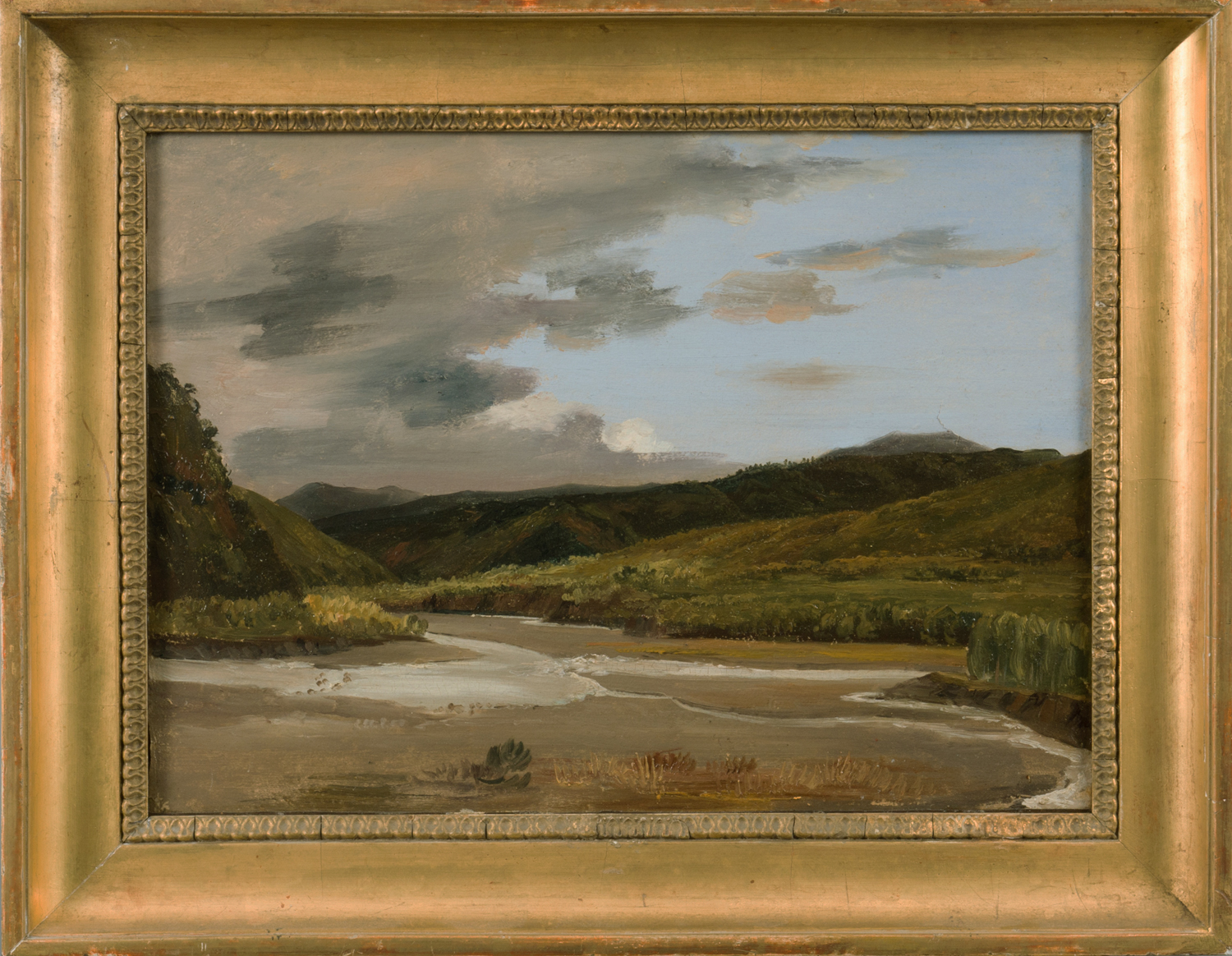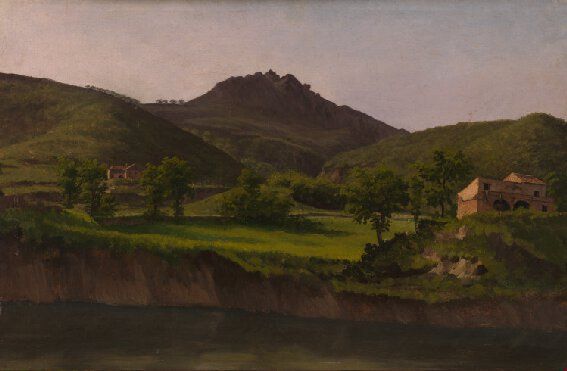Attributed to JULES-LOUIS-PHILIPPE COIGNET (Paris 1798 – 1860 Paris)
Attributed to Jules-Louis-Philippe Coignet (Paris 1798 – 1860 Paris)
A River in a Hilly Landscape
Oil on paper laid down on canvas, 213 x 287 mm (8.4 x 11.3 inch); stretcher size 222 x 302 mm (8.7 x 11.9 inch); in a 19th-century gilt frame
Indistinctly inscribed in black chalk on the upper member of the stretcher
Provenance
~ Private collection, France
~ With Emmanuel Moatti, Paris
~ Anonymous sale, Sotheby’s, London, 7 July 2011, lot 127, repr. (as ‘attributed to Jules Coignet’)
~ Private collection, The Netherlands, until 2017
***
Jules-Louis-Philippe Coignet studied with the influential Neoclassical landscape painter Jean Victor Bertin (1767–1842) and in 1821 was among the competitors for the Prix de Rome, specializing in ‘Historical Landscape’.1 From 1824 until 1857 he regularly exhibited at the Paris Salon, winning a gold medal in 1824. A constant traveller in search of picturesque motifs, not unlike his contemporary Corot, he carried his explorations as far as Egypt and Syria.
Although he had begun as a painter in the tradition of the composed, ‘historical’ landscape, his Salon submissions were for the most part topographical views, based on oil studies painted out-of-doors, en plein air. Painting oil sketches outdoors had become popular from the beginning of the century and was greatly stimulated by the invention of the paint tube in 1841 – before that, artists had used pig bladders and glass syringes to transport oil paints. In these studies, the raw material from which Coignet developed his exhibition pieces, he showed himself a fluent colourist, sensitive to effects of light and atmosphere: in short, a naturalist, whose painterly, observation-based work contains no trace of Neoclassical stylization.
Unlike other landscapists formed, like himself, in the school of Pierre-Henri de Valenciennes (1750-1819), Bertin,and Achille-Etna Michallon (1796-1822), he did not construct his landscapes piecemeal by an addition of parts but aimed from the outset for the entire image. In his finished paintings, his reliance on direct experience allowed him to dispense with the fictions by which other painters sought to heighten the significance of their landscapes. His Salon submissions contained no mythical or historical motifs. A prolific and careful draftsman, Coignet produced a large body of pencil drawings (many of them now at the Musée d'Art of Clermont-Ferrand). He was influential as a teacher; his studio attracted numerous students and in 1848 he published a treatise on landscape painting, Cours Complet de Paysage.
Coignet was already painting plein air sketches during the early 1830s, and a rare dedicated sale of a series of these sketches made in France, Switzerland and Italy was offered at public auction in Paris in 1834.2 A River Landscape attributed to Coignet is part of the Gere Collection, now in the National Gallery, London (fig.).3 The loose handling and silhouettes of the tree tops on the distant ranges are comparable. In the broad execution of the sky, our sketch is comparable to Coignet’s Sunset over the River Rhine with the City of Bonn Beyond, datable to around 1829, which was on the art market in 2007.4 Our sketch is likely to date from the same period, around 1830. It is obvious that the loose touch developed by the plein-air painters was highly influential to the Impressionists of the following generation.
SOLD
1. For the artist, see the biography in Saur Allgemeines Künstlerlexikon: die bildenden Künstler aller Zeiten und Völker, Munich 1992-, vol. 20, p. 181.
2. Catalogue d'une charmante collection d'études peintes a l'huile, dessins et aquarelles faits en France, en Suisse et en Italie, par Jules Coignet, Paris (Pétit) 22-23 December 1834 (Lugt 13836); a copy of the catalogue is preserved in the Rijksbureau voor Kunsthistorische Documentatie (RKD), The Hague.
3. Oil on paper laid on canvas, 252 x 384 mm; Christopher Riopelle and Xavier Bray, A Brush with Nature. The Gere Collection of Landscape Oil Sketches, London 2003, cat. no. 16, pp. 60-61, repr.
4. Oil on paper laid on canvas, 270 x 460 mm; with John Schlichte Bergen, Amsterdam, shown at TEFAF, Maastricht, March 2007; see colour repr. in The Burlington Magazine, Feburary 2007.
